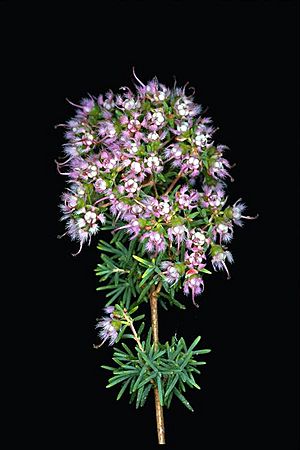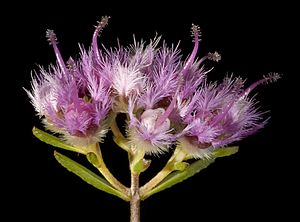Compacted featherflower facts for kids
Quick facts for kids Compacted featherflower |
|
|---|---|
 |
|
 |
|
| Verticordia densiflora var. densiflora | |
| Scientific classification | |
| Genus: |
Verticordia
|
| Species: |
densiflora
|
The Compacted Featherflower (scientific name: Verticordia densiflora) is a beautiful flowering plant. It belongs to the myrtle family, called Myrtaceae. This plant is special because it only grows naturally in the south-west part of Western Australia. It's a type of bush, or shrub, that has small leaves. Its flowers are usually small and come in shades of pink and white. You can find this plant in many places across the south-west of the state.
This plant can look a bit different depending on where it grows. In 1991, a scientist named Alex George studied it closely. He found and described five different types, or varieties, of this plant.
Contents
What Does It Look Like?
Verticordia densiflora is a shrub that grows with branches spreading out. It can reach a height of about 2 m (7 ft). The leaves on the plant can be different shapes. Some are long and thin, while others are more like an egg. The leaves closer to the flowers are usually wider than those lower down on the stem.
The flowers of the Compacted Featherflower have a nice smell. They grow in groups that look like a round cluster or a flat-topped bunch. These flower groups sit on upright stalks. The stalks can be from 1.5 to 9 mm (0.06 to 0.4 in) long. The length depends on the specific variety of the plant.
Each flower has a small, cup-shaped base called a floral cup. It's about 1.5 mm (0.06 in) long and feels smooth. However, it has tiny hairs near its bottom. The sepals, which are like small leaves protecting the flower bud, can be pink, cream, pale yellow, or sometimes white. They are about 2–4 mm (0.08–0.2 in) long. Each sepal has three parts, and these parts have a fringe of rough hairs.
The petals are similar in color to the sepals. They are about 0.8–2.0 mm (0.03–0.08 in) long and shaped like an egg. Their ends have many tiny threads or filaments. The style, which is part of the flower's reproductive system, is 4–6 mm (0.16–0.24 in) long. It sticks out past the petals and is curved and hairy. The time when these plants bloom can also vary depending on the variety.
Plant Names and History
The Compacted Featherflower was first officially described in 1839. This description was made by a botanist named John Lindley. It was published in a book called A Sketch of the Vegetation of the Swan River Colony. The first samples of this plant were collected near the Swan River. They were found by another botanist, James Drummond.
The scientific name densiflora comes from two Latin words. Densus means "dense" or "crowded." -florus means "flowered." So, densiflora refers to how the flowers grow in a dense or crowded group.
In 1991, Alex George studied the Verticordia group of plants. He identified five different varieties of Verticordia densiflora:
- Verticordia densiflora var. densiflora has leaves that are 0.8–1.2 mm (0.03–0.05 in) wide near the flowers. Its flower stalks are less than 4 mm (0.2 in) long. The flowers are pink or pink and cream. The sepals are 2–2.2 mm (0.08–0.09 in) long, and the petals are 0.8–1.0 mm (0.03–0.04 in) long.
- Verticordia densiflora var. cespitosa has similar leaves and flower arrangements. However, its sepals (2.5–3.5 mm (0.098–0.14 in)) and petals (0.8–1.0 mm (0.03–0.04 in)) are longer than var. densiflora.
- Verticordia densiflora var. pedunculata has the longest flower stalks. These are mostly 5–9 mm (0.2–0.4 in) long. Its sepals (3.8–4 mm (0.1–0.2 in)) and petals (1.6–2.0 mm (0.06–0.08 in)) are also the longest among the varieties.
- Verticordia densiflora var. rosteostella has wider leaves, about 2.0–2.5 mm (0.08–0.1 in) wide near the flowers. Its flower stalks are less than 4 mm (0.2 in) long. The flowers are pink or pink and cream and grow in small, rounded groups. The sepals are 2–3.5 mm (0.08–0.1 in) long, and petals are 0.8–1.9 mm (0.03–0.07 in) long.
- Verticordia densiflora var. stelluligera is much like var. rosteostella. The main difference is that its flowers are yellow or cream-colored.
Alex George grouped this species with other similar plants. These include V. polytricha, V. brownii, V. eriocephala, and V. capillaris.
Where Does It Grow?
This type of verticordia plant grows in many different kinds of soils. It also grows in various plant communities across the south-west of Western Australia. Each variety of the plant has slightly different needs for where it likes to grow.
Protecting the Plant
One variety, pedunculata, is the rarest of the five types. The Western Australian Government's Department of Parks and Wildlife lists it as "Threatened Flora." This means it is a rare plant that needs protection. The Australian Government also lists it as "Endangered" under the Environment Protection and Biodiversity Conservation Act 1999 (EPBC Act).
Another variety, rosteostella, is listed as "Priority Three." This means we don't know much about it, and it's only found in a few places. However, it's not currently in immediate danger of disappearing. The other three varieties are not considered threatened.
Growing It in Gardens
Many types and forms of this plant have been grown successfully in gardens. They are quite tough and can grow in different soils and conditions. Most of them can be grown from cuttings. They are also considered good plants for gardens because of their beauty.

